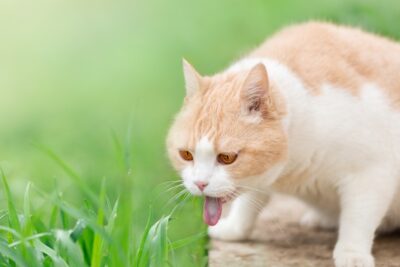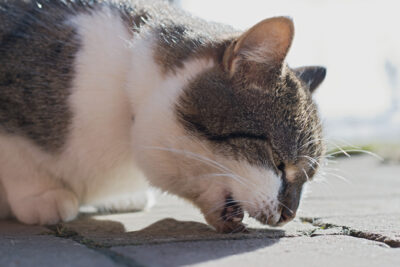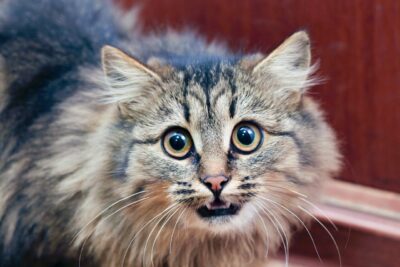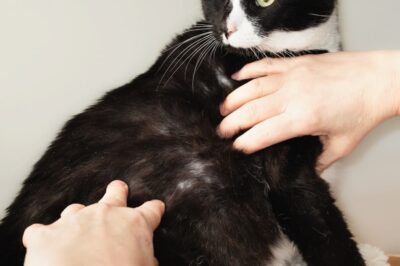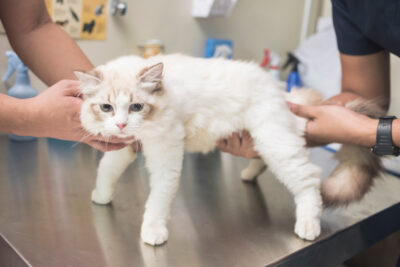Why Is My Cat Itching and Licking So Much?

All featured products are chosen at the discretion of the GreatPetCare editorial team and do not reflect a direct endorsement by the author or reviewer.
Ever wonder why your cat is itching and licking so much? Cats have meticulous grooming habits. But when this behavior becomes excessive, it’s a cause for concern. Intense itching and licking in cats signals an underlying health or behavioral issue. It can lead to skin irritation, hair loss, and even open wounds that can become infected.
Figuring our why your kitty is itching and licking so much is important for getting them the right care. Read on to learn what may be behind your cat’s discomfort and how to address it.
Why Is My Cat Itching and Licking So Much? 8 Common Causes
There are several potential causes of excessive feline licking. According to Dr. Colleen Lambo, DVM, a veterinarian with the national mobile pet care service The Vets, the top three reasons are parasites, allergies, and psychological factors. Let’s break down these common causes below.
Flea Allergy Dermatitis
Flea bites are by far the most common allergy affecting cats, says Dr. Carol Osborne, DVM, founder of Chagrin Falls Veterinary Center & Pet Clinic. These tiny parasites bite and feed on your cat’s blood. The proteins in the flea’s saliva can trigger an allergic reaction on the cat’s skin known as flea allergy dermatitis (FAD). You may know it as hot spots.
This condition leads to intense scratching, excessive grooming and sometimes hair loss. Flea allergy dermatitis also causes a unique skin condition called miliary dermatitis. This condition shows up as small crusty bumps all over the body. The constant scratching and licking can cause more damage, resulting in open sores and yeast and bacterial infections.
Cats can get fleas through contact with other flea-infested animals, like other cats, dogs, or wildlife. They can also pick up fleas from contaminated outdoor and indoor environments. These can include grass, carpet, throw rugs, leaf litter, mulch, and bedding where fleas eggs, larvae, or adult fleas are present. Fleas can and do jump onto cats and dogs from these surfaces, leading to an infestation.
Mites
What if your cat is itching but there are no fleas present? It might be mites.
Mites are microscopic parasites that chew on and burrow into a cat’s skin. Certain types of mites can cause a skin disease called mange, leading to hair loss, skin redness, and scabs and lesions from scratching. Other types of mites, like ear mites, can cause itching around the ears and head, leading to excessive scratching or head shaking. Associated symptoms include black debris in ears and secondary ear infections.
Cats can get mites through contact with infected animals or a contaminated environment. Additionally, kittens can contract mites from their mother during grooming and nursing.
Ringworm
Despite its name, ringworm is not caused by a worm. Instead, a group of fungi called dermatophytes infect a cat’s skin, hair, and nails. This fungal infection can cause cause major irritation and discomfort, making cats scratch and lick the affected areas.
Ringworm usually looks like circular patches of hair loss with red, scaly skin. But it can also show up as irregular red skin lesions, general hair loss, or no symptoms at all! Ringworm fungi thrive in warm, moist environments. They’re very contagious to other cats, pets, and people. Ringworm spreads through direct contact or contaminated objects like bedding, grooming tools, or furniture.
Environmental Allergies
If your cat is itching a lot but doesn’t have fleas or other parasites, an environmental allergy could be to blame. This happens when a has a reaction to things in their surroundings like pollen, dust mites, or mold. These allergens can cause skin irritation, leading your cat to excessively lick, chew, or itch themselves.
Food Allergies
Certain ingredients in your cat’s diet can trigger an allergic reaction. Food allergies in cats are most often caused by the proteins in their food. Dr. Lambo says this reaction often manifests as very itchy skin, usually affecting the ears, face, and paws. Cats with ingredient sensitivities often have digestive signs as well as skin signs. Chronic licking and scratching can lead to hair loss and skin infections if the food allergy isn’t managed well.
Contact Dermatitis
Contact dermatitis happens when a cat’s skin reacts to substances it touches. These include certain cleaning products, fabrics, plants, or topical shampoos or medications. This causes localized itching and redness. The cat’s attempts to soothe the irritation through licking and scratching can cause further skin damage and infection.
Secondary Skin Infections
Secondary skin infections can develop as a result of excessive scratching and licking. Bacteria and yeast naturally live on skin. But when a cat has allergies or external parasites, these microorganisms can overgrow. The result is itching, pimples, pustules, hair loss, skin redness, and odor. Skin infections need treatment for the infection and the contributing underlying skin disorder.
Psychological Issues
If parasites or allergies aren’t the root of your cat’s licking and itching, consider their mental health. “Cats may excessively groom or lick themselves as a response to stress, anxiety, or boredom,” says Dr. Lambo. “This behavior can become compulsive and lead to skin irritation or hair loss over time.”
Diagnosing the Causes of Cat Itching and Licking
Excessive itching and licking usually signal underlying health issues that need professional diagnosis and treatment. Your vet will determine the cause and offer the right treatment to relieve your cat’s discomfort.
According to Dr. Lambo and Dr. Osborne, veterinarians use a variety of tests to diagnose the cause of a cat’s itching and licking, including:
- Physical examination: Your vet will do a thorough exam to check for visible signs of fleas, mites, infections, or skin irritation.
- Skin scraping: This entails collecting skin samples to check for mites and other parasites under a microscope.
- Skin allergy testing: Veterinary dermatologists perform this procedure, which requires sedation and shaving a testing area on the skin. In this test, the vet injects small amounts of allergens under the skin to see if the cat has allergic reactions. From the results of this test, the vet can create ‘allergy shots’ that aim to reduce an allergic cat’s symptoms.
- Elimination diet: Veterinarians recommend an elimination diet if they suspect a food allergy. This process involves systematically removing foods from your cat’s diet until symptoms improve. A prescription allergy food is usually prescribed during a food trial. The trial can last up to eight weeks, and your cat cannot eat anything outside of the prescribed food. This includes treats, human foods, flavored medications, and even outdoor animals (like mice). To confirm a specific food as the culprit, you add that food back into your cat’s diet to see if the symptoms reappear. You should eliminate any offending foods from your cat’s diet.
- Skin culture: This test is for diagnosing ringworm and resistant bacterial infections.
- Skin biopsy: Done for cases of chronic skin conditions, this involves taking a small sample of your cat’s skin and sending it to a lab for examination.
In some complex cases, a veterinarian may refer you to a board-certified veterinary dermatologist. These specialists have advanced training in diagnosing and treating complex skin conditions.
Treatment for Cat Itching and Licking (Plus, Product Recommendations)
Once you find the cause of a cat’s excessive itching and licking, your vet will create a treatment plan. It may involve a combination of allergen avoidance, medical therapies, environmental changes, and preventative measures. Some common components of treatment for excessive itching and licking include:
Flea Control
Treatment for cats diagnosed with flea allergy dermatitis involves eliminating fleas and their eggs from your cat and their environment by cleaning and/or using flea control products. According to Dr. Osborne, this usually entails:
- Medicated shampoo: Bathing cats with a medicated shampoo can help get rid of a flea infestation. These shampoos help soothe irritated skin and remove any fleas present on your cat’s skin.
- Topical or oral flea medications: Flea medicines like a spot-on treatment, oral tablet, or flea collar help get rid of fleas and prevent re-infestation. A flea preventative should be given monthly thereafter.
- Environmental cleaning: Cleaning your living space and clearing your yard can help get rid of fleas, flea eggs, and flea larvae that could re-infest your cat.


Allergy Management
Treatment for allergies depends on the type of allergy your cat is dealing with. Options may include:
- Diet change: For food allergies, switching your cat to a diet free from the offending ingredient(s) can soothe symptoms.
- Avoid contact: For contact allergies, avoid exposing your cat to the allergen. For instance, if your cat is sensitive to wool, remove their access to that material.
- Environmental control: Avoiding allergens like house dust and pollen can be trickier. You can try to minimize exposure to environmental allergens like pollen, dust mites, and mold through regular cleaning, keeping windows closed on high pollen days, and air filtration.
- Allergy medications: If environmental control is not enough to tame your cat’s symptoms, cat allergy medications, such as Atopica or antihistames, may help. In more severe cases, Dr. Osborne says inhaled steroids and bronchodilators are available to bring respiratory relief that can occur in addition to itching.
- Allergy shots: Dr. Osborne says allergy shots (aka allergen immunotherapy) can help reduce your cat’s allergies by desensitizing the body to the offending allergen.


Treating Infections
If your cat has secondary infections, your veterinarian will want to address them promptly with medication. This may include oral antimicrobials, injectable antibiotics, or topical antimicrobial medications like Tresaderm. Your veterinarian may also recommend giving your cat an anti-inflammatory medication to reduce symptoms.
Addressing Psychological Problems
For cats who have itching and licking related to anxiety, it’s important to implement techniques to reduce stress. This may include:
- Providing more environmental enrichment
- Establishing a routine
- Using calming products like Feliway pheromone diffusers
- Removing any controllable stressors (such as playing loud music)
In some cases, your veterinarian may prescribe your cat anti-anxiety medications or supplements to help manage stress-related behaviors.

Skin Care
Certain products can help soothe your cat’s itchy skin and maintain overall good skin health. These may include:
- Supplements: Certain supplements, such as fish oil and hemp oil, are rich in omega-3 fatty acids and can help reduce skin inflammation and improve skin health.
- Topicals: Using topical products like coconut oil and anti-itch cream for cats on patches of irritated, dry skin can help hydrate and provide itch relief.
- Humidifier: If the air is dry where you live, consider using a humidifier in your home. This may help improve your cat’s dry skin.


Regular Veterinary Check-Ups
Regular checkups with your veterinarian are essential to monitor your cat’s condition and adjust the treatment plan as needed. Continuous monitoring helps ensure the treatment is effective and allows for timely adjustments if new issues arise.
By understanding and addressing the reasons behind your cat’s itching and licking, you can help your furry friend find the comfort they deserve and keep those happy purrs coming.
